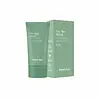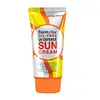What's inside
What's inside
 Key Ingredients
Key Ingredients

 Benefits
Benefits

 Concerns
Concerns

 Ingredients Side-by-side
Ingredients Side-by-side

Water
Skin ConditioningPropanediol
SolventHomosalate
Skin ConditioningButyloctyl Salicylate
Skin ConditioningEthylhexyl Salicylate
UV AbsorberCI 77891
Cosmetic ColorantDiethylamino Hydroxybenzoyl Hexyl Benzoate
UV FilterSilica
AbrasiveAcrylates Copolymer
Polysorbate 60
EmulsifyingGlyceryl Stearate
EmollientBeeswax
Emulsion StabilisingBis-Ethylhexyloxyphenol Methoxyphenyl Triazine
Skin ConditioningCetyl Dimethicone
EmollientSodium Stearoyl Lactylate
EmulsifyingPEG-100 Stearate
Caprylyl Glycol
EmollientC20-22 Alkyl Phosphate
EmulsifyingSorbitan Stearate
EmulsifyingAluminum Hydroxide
EmollientC20-22 Alcohols
Emulsion StabilisingPolyhydroxystearic Acid
EmulsifyingPortulaca Oleracea Extract
Skin ConditioningStearic Acid
CleansingParfum
MaskingXanthan Gum
EmulsifyingAcrylamide/Sodium Acryloyldimethyltaurate Copolymer
Emulsion Stabilising1,2-Hexanediol
Skin ConditioningTromethamine
BufferingSodium Polyacryloyldimethyl Taurate
Emulsion StabilisingIsohexadecane
EmollientBenzotriazolyl Dodecyl P-Cresol
UV AbsorberNeopentyl Glycol Diethylhexanoate
EmollientDisodium EDTA
Polysorbate 80
EmulsifyingPPG-17
Skin ConditioningSorbitan Oleate
EmulsifyingMelaleuca Alternifolia Leaf Extract
PerfumingLactose
HumectantCentella Asiatica Extract
CleansingPhenethyl Alcohol
MaskingWater, Propanediol, Homosalate, Butyloctyl Salicylate, Ethylhexyl Salicylate, CI 77891, Diethylamino Hydroxybenzoyl Hexyl Benzoate, Silica, Acrylates Copolymer, Polysorbate 60, Glyceryl Stearate, Beeswax, Bis-Ethylhexyloxyphenol Methoxyphenyl Triazine, Cetyl Dimethicone, Sodium Stearoyl Lactylate, PEG-100 Stearate, Caprylyl Glycol, C20-22 Alkyl Phosphate, Sorbitan Stearate, Aluminum Hydroxide, C20-22 Alcohols, Polyhydroxystearic Acid, Portulaca Oleracea Extract, Stearic Acid, Parfum, Xanthan Gum, Acrylamide/Sodium Acryloyldimethyltaurate Copolymer, 1,2-Hexanediol, Tromethamine, Sodium Polyacryloyldimethyl Taurate, Isohexadecane, Benzotriazolyl Dodecyl P-Cresol, Neopentyl Glycol Diethylhexanoate, Disodium EDTA, Polysorbate 80, PPG-17, Sorbitan Oleate, Melaleuca Alternifolia Leaf Extract, Lactose, Centella Asiatica Extract, Phenethyl Alcohol
Water
Skin ConditioningEthylhexyl Methoxycinnamate
UV AbsorberTitanium Dioxide
Cosmetic ColorantButylene Glycol
Humectant4-Methylbenzylidene Camphor
UV AbsorberDicaprylyl Carbonate
EmollientBeeswax
Emulsion StabilisingCetearyl Alcohol
EmollientPolyglyceryl-3 Methylglucose Distearate
EmulsifyingStearyl Alcohol
EmollientCaprylic/Capric Triglyceride
MaskingGlyceryl Stearate
EmollientDimethicone
EmollientTocopheryl Acetate
AntioxidantHydrolyzed Collagen
EmollientXanthan Gum
EmulsifyingAloe Barbadensis Leaf Extract
EmollientMorus Alba Bark Extract
Skin ConditioningDisodium EDTA
Hydroxyethylcellulose
Emulsion StabilisingDipotassium Glycyrrhizate
HumectantAllantoin
Skin ConditioningBetaine
HumectantResveratrol
AntioxidantAllium Grayi Callus Culture Extract
Skin ProtectingActinidia Deliciosa Fruit Extract
Skin ConditioningOlivine Extract
Skin ConditioningHydrolyzed Grape Fruit Extract
HumectantPyrus Malus Fruit Extract
Skin ConditioningStomach Extract
HumectantCitrus Aurantium Dulcis Fruit Extract
Masking1,2-Hexanediol
Skin ConditioningWater, Ethylhexyl Methoxycinnamate, Titanium Dioxide, Butylene Glycol, 4-Methylbenzylidene Camphor, Dicaprylyl Carbonate, Beeswax, Cetearyl Alcohol, Polyglyceryl-3 Methylglucose Distearate, Stearyl Alcohol, Caprylic/Capric Triglyceride, Glyceryl Stearate, Dimethicone, Tocopheryl Acetate, Hydrolyzed Collagen, Xanthan Gum, Aloe Barbadensis Leaf Extract, Morus Alba Bark Extract, Disodium EDTA, Hydroxyethylcellulose, Dipotassium Glycyrrhizate, Allantoin, Betaine, Resveratrol, Allium Grayi Callus Culture Extract, Actinidia Deliciosa Fruit Extract, Olivine Extract, Hydrolyzed Grape Fruit Extract, Pyrus Malus Fruit Extract, Stomach Extract, Citrus Aurantium Dulcis Fruit Extract, 1,2-Hexanediol
Ingredients Explained
These ingredients are found in both products.
Ingredients higher up in an ingredient list are typically present in a larger amount.
1,2-Hexanediol is a synthetic liquid and another multi-functional powerhouse.
It is a:
- Humectant, drawing moisture into the skin
- Emollient, helping to soften skin
- Solvent, dispersing and stabilizing formulas
- Preservative booster, enhancing the antimicrobial activity of other preservatives
Beeswax is natural wax produced by honey bees and can be synthetically created. It consists mainly of fatty acid esters and long-chain alcohols.
In cosmetics, beeswax is a emollient. Due to its waxy structure, it creates a protective barrier. This barrier prevents water from evaporating off the skin.
This may not be a good ingredient for oily skin. We recommend speaking with a professional if you have concerns.
Beeswax cannot be removed with water, but can be taken off with an oil cleanser.
Beeswax is also antiseptic and contains vitamin A.
Learn more about BeeswaxDisodium EDTA plays a role in making products more stable by aiding other preservatives.
It is a chelating agent, meaning it neutralizes metal ions that may be found in a product.
Disodium EDTA is a salt of edetic acid and is found to be safe in cosmetic ingredients.
Learn more about Disodium EDTAGlyceryl Stearate is a mix of glycerin and stearic acid.
It is used to stabilize the mixing of water and oil ingredients. By preventing these ingredients from separating, it can help elongate shelf life. It can also help thicken the product's texture.
As an emollient, it helps soften skin and supports barrier-replenishing ingredients.
In cosmetics, Glyceryl Stearate is often made from vegetable oils or synthetically produced.
This ingredient may not be fungal-acne safe
Fun fact: The human body also creates Glyceryl Stearate naturally.
Learn more about Glyceryl StearateWater. It's the most common cosmetic ingredient of all. You'll usually see it at the top of ingredient lists, meaning that it makes up the largest part of the product.
So why is it so popular? Water most often acts as a solvent - this means that it helps dissolve other ingredients into the formulation.
You'll also recognize water as that liquid we all need to stay alive. If you see this, drink a glass of water. Stay hydrated!
Learn more about WaterXanthan gum is used as a stabilizer and thickener within cosmetic products. It helps give products a sticky, thick feeling - preventing them from being too runny.
On the technical side of things, xanthan gum is a polysaccharide - a combination consisting of multiple sugar molecules bonded together.
Xanthan gum is a pretty common and great ingredient. It is a natural, non-toxic, non-irritating ingredient that is also commonly used in food products.
Learn more about Xanthan Gum